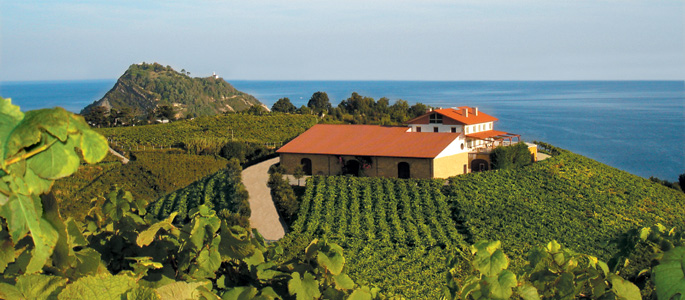Viticulture in the Basque Country has special characteristics
- The term txakoli means “homemade wine” or “wine made in the farmhouse”. In the production process of this beverage we wanted to know the special characteristics of the viticulture of Euskal Herria, and for this we have approached Getaria.

Viticulture is a tradition that has passed from generation to generation, from hand to hand, in the Txakolí winery Txomin Etxaniz of Getaria. We have been quoted by one of those responsible, Iñaki Txurruka, who told us the secrets of the land surrounding the winery and the txakoli with which they live. The house is surrounded by a beautiful place, with a large sea to the height and with its vetust slopes that resemble abyss.
In this guided tour, the first thing we have done is look back: In some documents of the year 1500 there are references to the vineyards of the area. “The first reference of the vineyard of our family dates from 1649. In particular, it appears in a document by Oñati.” Since then, five generations of the same family have been in charge of maintaining it. “Getaria has been especially a fishing village, in which fishing has predominated in wealth and way of life. But in our family it has not been so.” Not only in Getaria, the txakoli has been made and done throughout the Basque Country. At the beginning of the 20th century it was of great importance in Lapurdi, Baja Navarra and Zuberoa. In the case of Navarra, it is carried out mainly in the region of Pamplona and in the area of Aoiz. In the past, Ezkaba's txakoli was well known, but today they do it for home, they don't market it. The production vineyards of txakoli currently occupy 700 hectares in the Basque Country, of which some 350 are located in Getaria, some 300 hectares in Bizkaia and some 77 in Álava. More than 330,000 bottles were produced in Álava in 2010 and in the coming years the quantity is expected to increase. However, it is in Bizkaia and Gipuzkoa where the most txakoli.Las characteristics of both
territories are similar, most of them are steep, as the lands surrounding Txomin Etxaniz. This makes the work difficult, since climate and land are not the most appropriate characteristics for the development of txakoli, which has forced the adaptation of viticulture in these years. “Because we are in need of sun, we place the vineyards in such a way that they can collect the sun we can,” Txurruka said. The cold wind is also harmful to the vineyards, so they put the vineyards behind the back to the wind that comes from Galicia. As the humidity is also not adequate, they are staggered to avoid them as far as possible and to receive the wind needed by the vineyards are located one meter high on the ground. All these characteristics give rise to a unique viticulture, as no other place of these characteristics is known.
In addition to this, the problems of the last harvest have to be added. “This year’s harvest has been very complicated. The wind had risen in the flower and became furious. The light was also big. I foresee that only four out of ten can be added,” Txurruka said. This year’s txakoli has been influenced by the climate since early spring and summer. Compared to the year 2012, the Bizkaia harvest has been reduced by 40%, reaching 999,428 litres of production. According to the Bizkaiko Txakolina Designation of Origin Regulatory Council, the weather in June was as follows: “The Txakoli of Bizkaia will be less and will also arrive later. The low temperatures of late spring or early summer have delayed the maturation of the vine.” Although to a lesser extent, its good quality stands out; although summer began with bad weather, the climatology of July and August has favored the arrival of the grapes.
In Gipuzkoa, the production of Getariako Txakolina decreased by 45% compared to 2012, while in Gipuzkoa it decreased by 4%. In particular, it is estimated that 1,500,000 kilos of grapes and, on average, 1,250,000 bottles. “This year’s txakoli has a lot of fruit flavor, a soft green color and a point of acidity.” This has been described by the experts.
Labour
“Everyone has to decide what land they have, what production they want to make, what kind of txakoli they bring out and what yield they can get. In the end, if you can't live from that with all of that, you have to change it and adapt it to the environment, to the land and to the market. Still, we have a debate on that topic,” said Txurruka.
The owners have emphasized that txakoli has a great labor force, although they have managed to mechanize various treatments. For example, when the slopes are 28% or 30%, machines cannot be introduced, which makes it difficult to work. In the winery of txakoli Txomin Etxaniz, next to the winery, there is a large slope, and for the land to be useful, steps of about two meters have been made to obtain yield. “It’s hard to keep big earrings, because there are slips, but we think it’s important to take advantage of it.” The vineyards are placed in line on this slope, otherwise the land is not usable. They have put two or three jobs at a cost and made us profitable.
The whole vineyard is popped and then tied, it is also made by hand. “We work 42 hectares and another 20 hectares of vineyards. In total we are working sixteen people and I think it is a good way to create jobs.”
From grape to bottle
The white txakoli is probably the best known, ahead of black or red. In Getaria, for example, 97% of the total txakoli is white. For the production of txakoli, two grapes are used: Ondarrabi Zuria and Ondarrabi Beltza. The first is the basis of the txakoli, which gives it vitality and acidity. The acidity of the second is lower and decreases the aggressiveness of the target, balances it. In the Basque Country there is not much habit of drinking red txakoli, but on the outside, above all they export to America. “They say they like it a lot, more than they do here. We like the strongest drinks; red is not that hard,” the chacolero explained.
The black grape also serves to make white txakoli. You have to decide what kind of txakoli you want before entering the lagar, as you take one or the other color during the time it occurs. After passing through the lagar, the must has been removed and introduced into two pots for washing for 24 hours. “It always brings some litter, a little sand. With the cold, it refreshes and lets itself be cleaned.” Then they take the must clean and pass it to the boiling vessels. “The rest is carried by a tractor, we analyze it and we recycle it as a fertilizer for the vineyards.” This requires a few years, but the process is becoming more and more widely used.
The must is fresh water, sugar water. This must goes through the fermentation process and becomes alcohol. At this stage, it produces carbon. It is advisable to keep the temperature under control, as if the temperature increases greatly, a high speed is reached and many aromatic components are removed, while if it is cold it will not be able to boil. “Therefore, you have to look for a space. We beauty around 16-18 degrees and control through computers so there are no problems.”
Once the desired product is obtained, they start bottling around February. But they're not bottling everything at once, they're embedding everything as needed, because it's well preserved in the pot.
Also back
In the winery of Txomin Etxaniz not only produce txakoli, but it is also a research space: they do tests with different vineyards. Currently, research work is being carried out with the universities in five boats of the winery. It serves them to see what characteristics and what type of yeast they want.
In addition, two other products are made: one is champagne – it is called birbirbirbirra in Euskal Herria and the base of txakoli, boiling – is taken, and the other is late. “This last one is the drink we stopped collecting when Pello Zabala tells us that autumn will be wonderful. We take the leaf out of those grapes so they get more sun, and so we get the grade up. The goal is to get as little water as possible and as much sugar as possible,” says Txurruka. When reaching the required border, a must rich in sugars is obtained and after boiling an alcohol of 12 degrees is obtained. Therefore, the temperature will be 12 degrees below zero and the temperature will be very good. “We let it do in many ottoons, but we get that good drying process every four years. On other occasions, it gets wet because it rains a lot or because of other factors. As you can see, in this house we take Pello’s words very much into account.” In the last eight years, they have only achieved the tardy three times, despite the efforts that will be made each year: “For us it is a whim, a different product; it is a very special wine, ideal for drinking at night.”
Txurruka has given us the opportunity to taste the drinks, and with that special taste we have finished our journey to the cavities of the txakoli. We have been recognized that they like guided tours: “Sharing the accounts here with the visitors and lovers of the wine world has its charm.”
In 2008, Luisja Oregon Iñurrieta and his family made the leap from town to village. It was installed in the Urkizahar farmhouse of Beizama (Gipuzkoa), which had been empty since the 1970s, and Oregon began producing eco-friendly txakoli. “Our goal has never been to produce in... [+]











